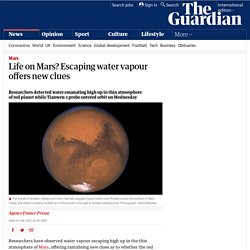

Nasa scientists hail Perseverance rover's arrival on Mars with stunning images. Nasa scientists have said the Perseverance Mars rover is “healthy” and is beaming back many stunning new images from the surface of the planet, promising significant scientific discoveries ahead.

At a celebratory press conference on Friday, one day after the rover’s landing, Nasa shared new images, including the first color pictures beamed directly from Mars as opposed to images touched up later. Life on Mars? Escaping water vapour offers new clues. Researchers have observed water vapour escaping high up in the thin atmosphere of Mars, offering tantalising new clues as to whether the red planet could have once hosted life.

The traces of ancient valleys and river channels suggest liquid water once flowed across the surface of Mars. What a picture of Alexandria Ocasio-Cortez in a bikini tells us about the disturbing future of AI. Want to see a half-naked woman?

Well, you’re in luck! The internet is full of pictures of scantily clad women. There are so many of these pictures online, in fact, that artificial intelligence (AI) now seems to assume that women just don’t like wearing clothes. Is there life on Mars? Not if we destroy it with poor space hygiene. Next month, three new spacecraft arrive at Mars.

Two represent firsts for their countries of origin, while the third opens a new era of Mars exploration. The first is the UAE’s Emirates Mars Mission, also known as Hope, which enters orbit on 9 February. The truth is out there … perhaps: CIA releases thousands of UFO files. The truth is out there.

Well, maybe. Thousands of documents from the CIA on unidentified flying objects were released this week in a document dump that the agency says includes all their records on UFOs. Scientists looking for aliens investigate radio beam 'from nearby star' Astronomers behind the most extensive search yet for alien life are investigating an intriguing radio wave emission that appears to have come from the direction of Proxima Centauri, the nearest star to the sun.

The narrow beam of radio waves was picked up during 30 hours of observations by the Parkes telescope in Australia in April and May last year, the Guardian understands. Scientists find gas linked to life in atmosphere of Venus. Dark matter: What is it, how do we know it's there and will we find it? It sounds like science fiction to say there’s invisible, undetectable stuff all around us, and it doesn’t help that it has the spooky name of dark matter.

'It is about our survival': UAE's Mars mission prepares for launch. He Arab world’s first interplanetary mission, due to launch in 40 days’ time and reach the orbit of Mars in February next year, is about the survival and future of the entire Middle East, the leaders of the United Arab Emirates project have declared.

The mission is also the latest sign that the old cartel of space exploration, once confined to the superpowers, is being broken up by new national entrants or private sector firms. The “Hope Mars mission”, due to be launched on 15 July, has been in preparation by the United Arab Emirates since 2014, and according to the project manager, Omran Sharaf, is seen as integral to the country’s long-term economic development. Astronomers watch as "exoplanet" vanishes before Hubble's eyes. Exoplanet discoveries are a dime a dozen – but we don’t see many being de-discovered.

Now, an exoplanet that was observed by Hubble for 10 years has apparently vanished without a trace, leading astronomers to suggest it may never have been a planet at all. The “planet” in question was named Fomalhaut b, and it was spotted orbiting a star just 25 light-years away from Earth. It was discovered in 2008, hiding in data collected in 2004 and 2006, and it was the first exoplanet to be directly imaged, as opposed to indirect detection methods like watching for effects it has on its parent star.
But a few years later it was gone. Fomalhaut b was clearly visible as a bright moving dot in about a decade’s worth of Hubble observations, but by 2014 it was no longer detectable in visible light nor infrared, leaving astronomers scratching their heads. Or, according to a new study by researchers at the University of Arizona, perhaps it was never a planet to begin with. Stretchable supercapacitors pave the way for super-flexy power sources. We've seen flexible supercapacitor designs before, but how about one that's stretchable?

A new discovery by researchers at Duke University and Michigan State University could lead to an excellent stretchable power source for wearable electronics. Supercapacitors, of course, are known for their excellent power density, charging and discharging a lot of energy quickly and having a longer lifespan than chemical batteries, which usually (but not always) have the advantage of storing significantly more energy. This research team set out trying to develop a truly flexible power source for the wearables they were working on. "Our goal is to develop innovative devices that can survive mechanical deformations like stretching, twisting or bending without losing performance,” said Yunteng Cao, director of the Laboratory for Soft Machines and Electronics at MSU.
Let's move to Mars: the best books about our future in space. It’s no longer a question of whether we’re going to Mars, but when. By the time we reach a second planet – probably in the 2030s – we’ll probably have a base or two on the moon as well. But will people ever live beyond Earth permanently? NASA installs Mars rover's sampling arm, plans for July launch. NASA is continuing to prepare its freshly named Mars 2020 rover for launch later this year, with the team successfully attaching the main sampling components that will be used to collect Martian rock and dust after touchdown. There are still a few finishing touches to be added to Perseverance ahead of lift-off, but the agency insists that the coronavirus pandemic hasn't impacted its plans and preparations are continuing as normal.
Perseverance is a 2,300-lb (1,043-kg) rover that will carry some of NASA's loftiest ambitions to Mars. It will land in the planet's Jezero Crater, where it will use its onboard instruments to hunt for signs of past microbial life, characterize the planet's climate, and gather samples to be studied back on Earth. All going to plan, these will be humanity's first samples from another planet. Key to this final objective is the Sample Handling Arm. The launch window for the Perseverance rover runs from July 17 to August 5. Source: NASA.